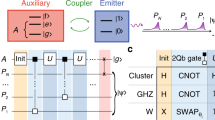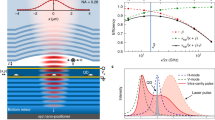Abstract
Engineering the quantum states of freely propagating light is of paramount importance for quantum technologies. As yet, the experimental generation of photonic states with negative Wigner functions has relied intrinsically on probabilistic schemes, heralded by the projection of a quantum measurement. Here we describe the fully deterministic preparation of freely propagating quantum states of light with negative Wigner functions, obtained by mapping the internal state of an intracavity Rydberg superatom onto an optical qubit encoded as a superposition of 0 and 1 photons. This approach enables us to reach a 60% photon generation efficiency in a well-controlled spatiotemporal mode while maintaining strong photon antibunching. By changing the qubit rotation angle, we observe an evolution from quadrature squeezing to Wigner negativity. Our experiment demonstrates this new technique as a viable method for deterministically generating non-Gaussian photonic resources, lifting several major roadblocks in optical quantum engineering.
This is a preview of subscription content, access via your institution
Access options
Access Nature and 54 other Nature Portfolio journals
Get Nature+, our best-value online-access subscription
$29.99 / 30 days
cancel any time
Subscribe to this journal
Receive 12 print issues and online access
$209.00 per year
only $17.42 per issue
Buy this article
- Purchase on Springer Link
- Instant access to full article PDF
Prices may be subject to local taxes which are calculated during checkout




Similar content being viewed by others
Data availability
The datasets generated and analysed during the current study are available from the corresponding author upon reasonable request.
References
Tse, M. et al. Quantum-enhanced advanced LIGO detectors in the era of gravitational-wave astronomy. Phys. Rev. Lett. 123, 231107 (2019).
Acernese, F. et al. Increasing the astrophysical reach of the Advanced Virgo detector via the application of squeezed vacuum states of light. Phys. Rev. Lett. 123, 231108 (2019).
Larsen, M. V., Guo, X., Breum, C. R., Neergaard-Nielsen, J. S. & Andersen, U. L. Deterministic generation of a two-dimensional cluster state. Science 366, 369–372 (2019).
Asavanant, W. et al. Generation of time-domain-multiplexed two-dimensional cluster state. Science 366, 373–376 (2019).
Walschaers, M. Non-Gaussian quantum states and where to find them. PRX quantum 2, 030204 (2021).
Bertet, P. et al. Direct measurement of the Wigner function of a one-photon Fock state in a cavity. Phys. Rev. Lett. 89, 200402 (2002).
Hofheinz, M. et al. Synthesizing arbitrary quantum states in a superconducting resonator. Nature 459, 546–549 (2009).
Lvovsky, A. I. & Shapiro, J. H. Nonclassical character of statistical mixtures of the single-photon and vacuum optical states. Phys. Rev. A 65, 033830 (2002).
Babichev, S. A., Ries, J. & Lvovsky, A. I. Quantum scissors: teleportation of single-mode optical states by means of a nonlocal single photon. Europhys. Lett. 64, 1 (2003).
Lvovsky, A. I. et al. Production and applications of non-Gaussian quantum states of light. Preprint at https://arxiv.org/abs/2006.16985 (2020).
Hacker, B. et al. Deterministic creation of entangled atom–light Schrödinger-cat states. Nat. Photonics 13, 110–115 (2019).
Senellart, P., Solomon, G. & White, A. High-performance semiconductor quantum-dot single-photon sources. Nat. Nanotechnol. 12, 1026–1039 (2017).
Schulte, C. H. H. et al. Quadrature squeezed photons from a two-level system. Nature 525, 222–225 (2015).
Tomm, N. et al. A bright and fast source of coherent single photons. Nat. Nanotechnol. 16, 399–403 (2021).
Vernaz-Gris, P., Huang, K., Cao, M., Sheremet, A. S. & Laurat, J. Highly-efficient quantum memory for polarization qubits in a spatially-multiplexed cold atomic ensemble. Nat. Commun. 9, 363 (2018).
Wang, Y. et al. Efficient quantum memory for single-photon polarization qubits. Nat. Photonics 13, 346–351 (2019).
Vaneecloo, J., Garcia, S. & Ourjoumtsev, A. Intracavity Rydberg superatom for optical quantum engineering: coherent control, single-shot detection, and optical π phase shift. Phys. Rev. X 12, 021034 (2022).
Tong, D. et al. Local blockade of Rydberg excitation in an ultracold gas. Phys. Rev. Lett. 93, 063001 (2004).
Jia, N. et al. A strongly interacting polaritonic quantum dot. Nat. Phys. 14, 550–554 (2018).
Stanojevic, J. et al. Controlling the quantum state of a single photon emitted from a single polariton. Phys. Rev. A 84, 053830 (2011).
Gorshkov, A. V., André, A., Lukin, M. D. & Sørensen, A. S. Photon storage in Λ-type optically dense atomic media. I. Cavity model. Phys. Rev. A 76, 033804 (2007).
Lukin, M. D. et al. Dipole blockade and quantum information processing in mesoscopic atomic ensembles. Phys. Rev. Lett. 87, 037901 (2001).
Straka, I. et al. Quantum non-Gaussian depth of single-photon states. Phys. Rev. Lett. 113, 223603 (2014).
Kumar, P., Aytür, O. & Huang, J. Squeezed-light generation with an incoherent pump. Phys. Rev. Lett. 64, 1015–1018 (1990).
Blow, K. J., Loudon, R., Phoenix, S. J. D. & Shepherd, T. J. Continuum fields in quantum optics. Phys. Rev. A 42, 4102–4114 (1990).
Lvovsky, A. I. Iterative maximum-likelihood reconstruction in quantum homodyne tomography. J. Opt. B 6, S556 (2004).
Kiilerich, A. H. & Mølmer, K. Input–output theory with quantum pulses. Phys. Rev. Lett. 123, 123604 (2019).
Kiilerich, A. H. & Mølmer, K. Quantum interactions with pulses of radiation. Phys. Rev. A 102, 023717 (2020).
Resch, K. J., Lundeen, J. S. & Steinberg, A. M. Quantum state preparation and conditional coherence. Phys. Rev. Lett. 88, 113601 (2002).
Lvovsky, A. I. & Mlynek, J. Quantum-optical catalysis: generating nonclassical states of light by means of linear optics. Phys. Rev. Lett. 88, 250401 (2002).
Carmichael, H. J. Photon antibunching and squeezing for a single atom in a resonant cavity. Phys. Rev. Lett. 55, 2790–2793 (1985).
McKeever, J. et al. Deterministic generation of single photons from one atom trapped in a cavity. Science 303, 1992–1994 (2004).
Keller, M., Lange, B., Hayasaka, K., Lange, W. & Walther, H. Continuous generation of single photons with controlled waveform in an ion-trap cavity system. Nature 431, 1075–1078 (2004).
Morin, O., Körber, M., Langenfeld, S. & Rempe, G. Deterministic shaping and reshaping of single-photon temporal wave functions. Phys. Rev. Lett. 123, 133602 (2019).
Schupp, J. et al. Interface between trapped-ion qubits and traveling photons with close-to-optimal efficiency. PRX quantum 2, 020331 (2021).
Ornelas-Huerta, D. P. et al. On-demand indistinguishable single photons from an efficient and pure source based on a Rydberg ensemble. Optica 7, 813–819 (2020).
Schlagmüller, M. et al. Ultracold chemical reactions of a single Rydberg atom in a dense gas. Phys. Rev. X 6, 031020 (2016).
Yang, C.-W. et al. Deterministic measurement of a Rydberg superatom qubit via cavity-enhanced single-photon emission. Optica 9, 853–858 (2022).
Stolz, T. et al. Quantum-logic gate between two optical photons with an average efficiency above 40%. Phys. Rev. X 12, 021035 (2022).
Yang, C.-W. et al. Sequential generation of multiphoton entanglement with a Rydberg superatom. Nat. Photonics 16, 658–661 (2022).
Beterov, I. I. et al. Quantum gates in mesoscopic atomic ensembles based on adiabatic passage and Rydberg blockade. Phys. Rev. A 88, 010303 (2013).
Omran, A. et al. Generation and manipulation of Schrödinger cat states in Rydberg atom arrays. Science 365, 570–574 (2019).
Varnava, M., Browne, D. E. & Rudolph, T. How good must single photon sources and detectors be for efficient linear optical quantum computation? Phys. Rev. Lett. 100, 060502 (2008).
Picken, C. J., Legaie, R., McDonnell, K. & Pritchard, J. D. Entanglement of neutral-atom qubits with long ground-Rydberg coherence times. Quantum Sci. Technol. 4, 015011 (2018).
Clark, L. W., Schine, N., Baum, C., Jia, N. & Simon, J. Observation of Laughlin states made of light. Nature 582, 41–45 (2020).
Schmidt-Eberle, S., Stolz, T., Rempe, G. & Dürr, S. Dark-time decay of the retrieval efficiency of light stored as a Rydberg excitation in a noninteracting ultracold gas. Phys. Rev. A 101, 013421 (2020).
Acknowledgements
This work was funded by the ERC Starting Grant 677470 SEAQUEL and the CIFAR Azrieli Global Scholars program. We thank P. Travers for technical support, and S. Ćuk and M. Enault-Dautheribes for their assistance at the early stage of the project.
Author information
Authors and Affiliations
Contributions
J.V., S.G. and A.O. built the experimental setup. V.M. and S.G. carried out the measurements. V.M., J.V. and S.G. performed the data analysis. A.O. developed the theory and numerical simulations. S.G. and A.O. wrote the paper with input from all authors.
Corresponding author
Ethics declarations
Competing interests
The authors declare no competing interests.
Peer review
Peer review information
Nature Photonics thanks Adam Miranowicz and the other, anonymous, reviewer(s) for their contribution to the peer review of this work.
Additional information
Publisher’s note Springer Nature remains neutral with regard to jurisdictional claims in published maps and institutional affiliations.
Supplementary information
Supplementary Information
Supplementary Figs. 1–4 and Discussion.
Rights and permissions
Springer Nature or its licensor (e.g. a society or other partner) holds exclusive rights to this article under a publishing agreement with the author(s) or other rightsholder(s); author self-archiving of the accepted manuscript version of this article is solely governed by the terms of such publishing agreement and applicable law.
About this article
Cite this article
Magro, V., Vaneecloo, J., Garcia, S. et al. Deterministic freely propagating photonic qubits with negative Wigner functions. Nat. Photon. 17, 688–693 (2023). https://doi.org/10.1038/s41566-023-01196-y
Received:
Accepted:
Published:
Issue Date:
DOI: https://doi.org/10.1038/s41566-023-01196-y



